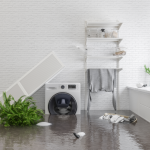About 71% of the earth is covered by water. We use it for cleaning, cooking, drinking, and swimming. We literally can’t live without it.
But within the context of our homes, it can spell disaster if it runs uncontrolled in basements, garages, crawl spaces, floors, or walls. In fact, water damage is the second-most frequently filed homeowner insurance claim. Statistically, you’re seven times more likely to experience water damage than fire damage, and six times more likely than a burglary.
Routine inspections and maintenance can help prevent black mold, rotted drywall and studs, ruined flooring, and other damage that can occur from uncontrolled water. Here are steps you can take to minimize the chance of water leaks and damage in your home.
- Know where your water main shutoff valve is and that it works properly
- Check downspouts and gutters for leaks, cracks, and badly sealed joints
- Check for cracked/missing caulking around the exterior of the home (doors, windows, etc.)
- Ensure your yard is properly graded to drain water away from your home
- Keep your roof in good shape
- Keep your interior drains clean and free-flowing
- If you have a chimney, ensure it has no cracks that can allow in water
- Monitor your water pressure by checking your monthly bill for sudden and unexplained increase in usage
- Make sure the sump pump in your basement or crawl space is working well
- Switch from copper pipes to PEX as you’re able or need to. Copper pipes can develop pinhole leaks as they age (especially around the 20+ year mark) and solder joints can fail.
- Check and reseal your basement, as needed
- Install a sewage backwater valve
- Inspect appliance hoses, faucets, water heater, showers, and tubs for cracks and leaks
- If you live where it freezes, consider an emergency pressure release valve
- Check sprinklers and irrigation to ensure they’re leak-free
- Consider storing valuables where the impact of water damage would be minimized (not in the basement, for example), or off the floor for items in the basement
- Have an up-to-date inventory of possessions, including digital images, that you can access in case of home damage or loss (and store the information in two places…your home and another off-site location)
While homeowners’ policies will generally cover water damage and flooding if it’s from a broken pipe or other in-home system, they may not cover damage from external flooding or mudflows from outside the home. Homeowners in flood-prone areas should strongly consider national flood insurance, and even homeowners in low-to-moderate risk areas might want to look into it.
Stay dry!









